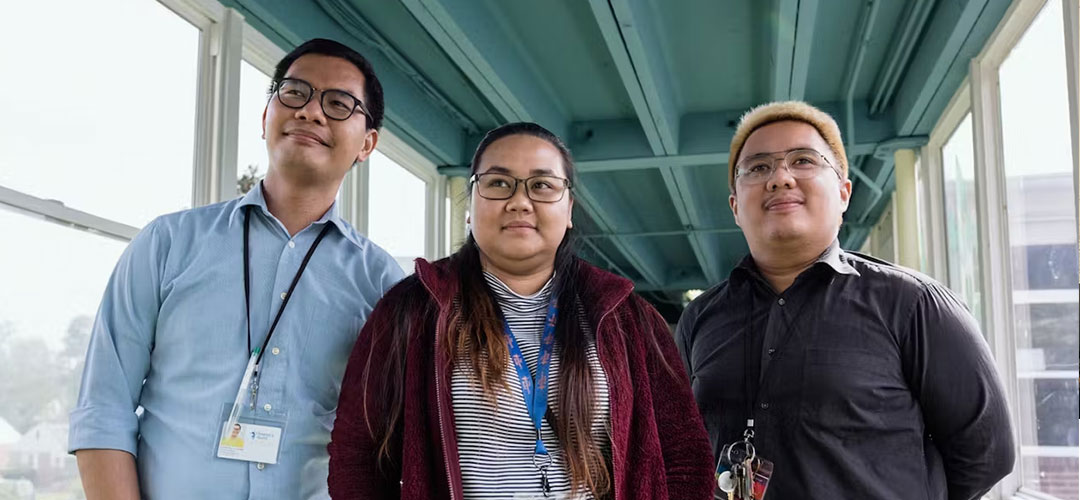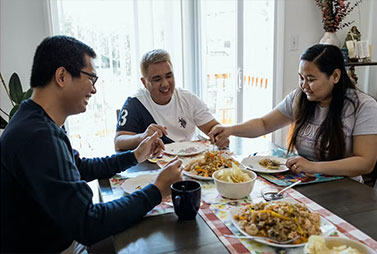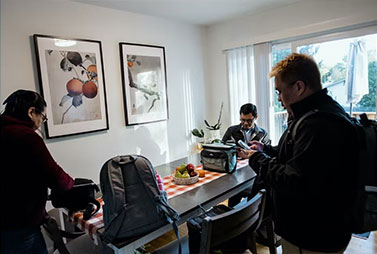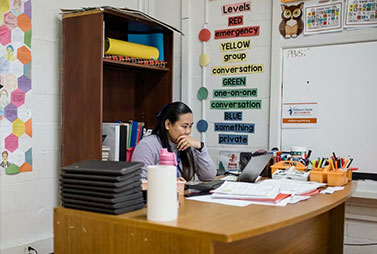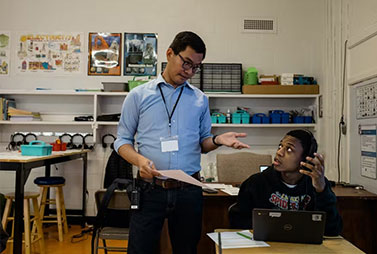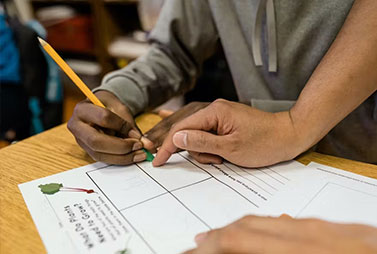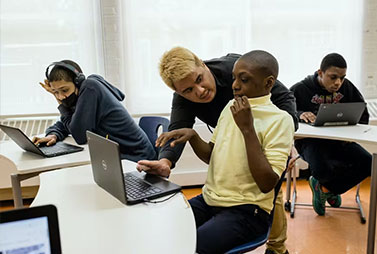Technology Is a Necessary Tool in Our Special Education Classrooms and Schools
This April, The Children’s Guild is proud to celebrate Autism Acceptance Month.
Since we started educating in 1953, we have been a leader and pioneer in special education and working with children on the autism spectrum. There’s been a lot of progress in special education. Schools like ours can make it easier for families to access resources and technology tools that assist children in the classroom, at home, and even at play outdoors and on the playground.
OUR EXPERIENCE
The Children’s Guild operates three non-public schools serving students with behavioral and academic disabilities including emotional disturbance, autism across the spectrum, developmental disabilities, and more. With a focus on special education—and different accompanying technologies—our students at The Children’s Guild School of Baltimore, The Children’s Guild School of Prince George’s County, and The Children’s Guild – Transformation Academy are successful both in and outside the classroom.
“We know that early intervention for special education is key to a child’s success,” says Vesna Grujicic, special education leader and Principal, The Children’s Guild -Transformation Academy. “Multidisciplinary teams that include professionals from various fields, such as medical, education, speech and language pathology, social work, occupational therapists, and parents, work collaboratively to meet the needs of every child with exceptionality by creating, implementing, and monitoring individualized educational plans. Additionally, nowadays technology plays a significant component in this process.”
ASSISTIVE TECHNOLOGIES AND TOOLS IN OUR CLASSROOMS
Special education technologies help our students learn while accommodating their individual learning styles and limitations. These technologies can also help them experience greater independence, less anxiety, and better connections with classmates.
There is a huge array of tools available for almost any need, and all are readily available to a student’s community, including, but not limited to, parents, specialists, and teachers.
There are several examples of how we use technology to help our students find success. For our vision-impaired students, magnifiers and talking devices open their world. For our hearing-impaired students, technology that includes vibrations, flashing lights, amplification, captioning, and more, is now available and widely used.
Speech communication: we encourage students to find their voice and communicate verbally with communication boards, speech output software, symbol-making software, and other technology.
Students who need mobility aids, such as wheelchairs, walkers, canes, crutches, scooters, and power chairs, keep up with their classmates in class and on the playground with the help of these technologies.
To ensure that every student has the resources they need to learn in the classroom, The Children’s Guild School of Prince George’s County received funding for assisted learning devices for students who need additional support. These assisted learning devices help students overcome any barriers to learning during the school year. The Children’s Guild School of Prince George’s County students are excelling in the classroom with the help of these devices.
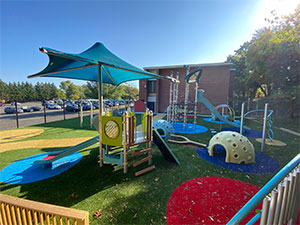
TECHNOLOGIES USED IN OUR PLAYGROUNDS
We believe every space should be accommodating for those with special needs. At the Children’s Guild – Transformation Academy, The Orokawa Foundation Playground is uniquely designed to meet the needs of students with exceptionalities. It is one among a few playgrounds in the nation that accommodate students’ sensory needs as well as educational needs.
“This new play space represents a significant milestone in our commitment to providing an inclusive educational environment. This space supports the social, emotional, and sensory needs of our students on the autism spectrum, empowering them to thrive,” says Vesna Grujicic, principal.
Playground design input came from physical therapists, occupational therapists, and other specialists from Transformation Academy and other special education organizations. The fence extends into the surrounding woods to make it seem more open. Slides sit side-by-side so kids, parents, and teachers can slide next to each other. A spinning structure called the We-Go-Round is designed for kids with wheelchairs. An enclosure offers peace and quiet if a student needs a break.
Kids with autism often have Sensory Processing Disorder and are sensitive to certain sounds or textures. So, playground benches are fabricated of smooth material and are many different colors to promote feelings of calm and curiosity. Musical bells and large xylophones offer calming sounds and the chance for students to make their own music.
A fun feature of the playground that is used in warmer weather includes a tower that can spray water on multiple children, making water fun and exciting for students who may be nervous or afraid of water. “Imagine you have a child that won’t take a shower,” says Mark Rapaport, managing director of autism services at The Children’s Guild. “Now kids can go outside and stand under a sprayer and they’re loving it. Why? Because they’re watching other kids do it.”

SENSORY AND VOCATIONAL ROOM TECHNOLOGIES
A sensory room is designed for anyone with neurodevelopmental or psychiatric conditions, such as a learning disability, anxiety, ADHD, autism, behavioral challenges, or mood disorders. They are created to be comfortable, dim, quiet, and secure so that the person can explore everything calmly and build confidence. We are proud to have sensory rooms at our schools in Maryland and Washington, DC. These spaces offer enormous value for both children and teachers in schools.
At The Children’s Guild -Transformation Academy in Baltimore, the Louise G. Goldberg Vocational Room helps students with skill development and job readiness. “This new space represents a significant milestone in our commitment to providing an inclusive educational environment. While performing assigned tasks, students are learning how to complete jobs that might include but are not limited to food preparation, sorting items, vacuuming, and shredding,” says Vesna Grujicic, principal.
The Children’s Guild School of Baltimore’s Career Center focuses on preparing students for life after high school. Teachers work with students on essential skills required for diverse career paths, whether pursuing higher education or entering the workforce. Mr. Randall Rykiel, a teacher in the career center, emphasizes the development of soft skills such as teamwork, communication, and work ethic, recognizing their universal importance in any job setting. Hands-on activities engage students with diverse interests and abilities and allow them to see the direct application of their skills in real-world scenarios.
“I love seeing them excited to come to class and do the work. I love seeing that they’re able to communicate what career they want to do.” — Randall Rykiel, Teacher, The Children’s Guild School of Baltimore.
WE ARE LEADERS IN SPECIAL NEEDS TECHNOLOGIES
More than seven decades of work with kids gives us powerful experience with special education and special needs technologies. We know technology doesn’t cure or eliminate learning difficulties, but we see it helping our students reach their potential allowing them to capitalize on their strengths.
We combine our deep experience and our unique educational approach of educating the whole child to help our students find success in and outside of the classroom.
It is because of our natural curiosity and always asking the question “Why?” – that we have discovered new ways of understanding autism spectrum disorder (ASD) and the most effective ways of working with children on the spectrum. We also ask the question “Why not?” and are striving to ensure that our students, their families, and our staff are equipped with the tools needed for success. Simply put, we aim to make the seemingly impossible, possible.
Interested in donating to support special education programs?
Did You Know?
In 2021–22, students in the U.S. ages 3–21 who received special education and/or related services under the Individuals with Disabilities Education Act (IDEA) was 7.3 million, or 15% of all public school students. Among students receiving special education and/or related services, the most common category of disability was specific learning disabilities (32%).
Source: National Center for Education Statistics).
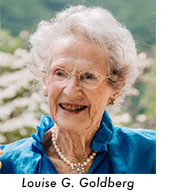 In honor of Louise G. Goldberg, a former dedicated teacher and board member of The Children’s Guild, generous donors helped create a vocational room at The Children’s Guild
In honor of Louise G. Goldberg, a former dedicated teacher and board member of The Children’s Guild, generous donors helped create a vocational room at The Children’s Guild

